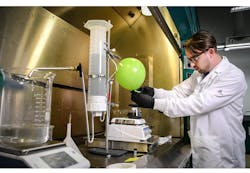Army Turns to Aluminum for Energy Production
Army engineers working at the Aberdeen Proving Ground facility in Maryland recently discovered that a nano-galvanic, aluminum-based powder produces high amounts of energy when it comes in contact with water, or with any liquid containing water.
The powder also hydrolyzes water, splitting it into two oxygen molecules and one hydrogen molecule. This portion of the discovery could lead to a new source of hydrogen for fuel or fuels cells.
Engineers have known for a long time that hydrogen can be harvested by adding a catalyst such as aluminum. But this method takes time, elevated temperatures, added electricity, and/or toxic chemicals (sodium hydroxide, potassium hydroxide, or acid).
“In our case, it does not need a catalyst,” says Anit Giri, a physicist with the lab. “Also, it is very fast. For example, we calculate that one kilogram of aluminum powder can produce 220 kilowatts of energy in just three minutes.
“That metric doubles if you consider the amount of heat energy produced by the exothermic reaction,” he continues. “And these rates are the fastest known without using catalysts such as an acid, base, or elevated temperature.”
The discovery is dramatic in terms of its potential. There are researchers who have spent their lives working on a process that takes hours and leads to perhaps a 50% increase in efficiency. This Army program, in contrast, has led to a 100% in efficiency increase and takes less than three minutes. The researchers note that 3D printers could use the nanomaterial to make object and components. This could lead to air and ground robots that use their structures for fuel and then self-destruct after mission completion.
Researchers said one possible application of the discovery that may help future soldiers is the potential to recharge mobile devices for recon teams.
Such teams are out in the field for three to five days, and that figure is based on how long their batteries will last. Recharging those batteries will let them remain in the field longer.

